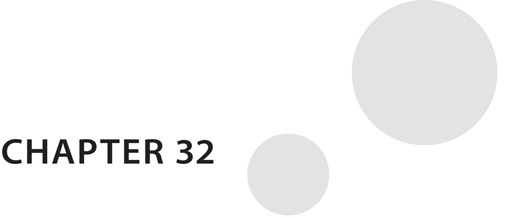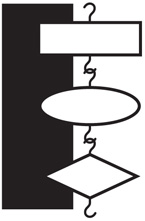

TINY SQUIGGLY PATTERNS in black on a white surface would seem to have little to do with the taste or texture of a sponge cake. Flour, eggs and butter would seem to have more to do with the cake, but even so they seem far removed from the finished cake. Yet the squiggly patterns in black on a white surface may be responsible for changing the flour, eggs and butter into the cake. The cake-making recipe is a written formula. The pattern set out in this formula is applied to the raw ingredients, and the result is a cake.
Mathematical thinking involves the use of such ready-made recipes. The recipes are not as specific as the cake-making ones but are general tricks and techniques for handling relationships. Some of the tricks and techniques are set out as detailed instructions, but it is more convenient to have general rules that can be applied in different combinations than to set out all the possible techniques. Mathematics is a game played with symbols and rules. The rules constitute a special universe in which things happen according to these rules. Anything enters this universe by being translated into a symbol. The symbol is processed according to the rules of the universe and then translated back at the end.
The rules and techniques of mathematics are worked out in advance, just as one might design and build a washing machine and then feed into it all sorts of laundry. Unlike what happens on the special memory-surface, the processing is not carried out by the information itself but arranged before the information ever arrives. Rather than let the information cut its own channels, these are dug beforehand and then the information has to follow these pre-set channels.
These pre-set channels are sometimes called algorithms. An algorithm is any fixed pattern which is not derived from presented information but serves to control and sort out that information. Algorithms may be mathematical techniques, but they may also be word patterns or any other type of pre-set pattern.
The Paul Jones was an algorithm which was often used at embarrassed dances when no one knew anyone else. The men linked hands to form a circle which revolved around a similar circle of women going in the opposite direction; when the music stopped the men were supposed to dance with the women in front of them. The whole procedure was an algorithm designed to process people into pairs.
Through their structure proteins can link up with one another, but the process would be rather haphazard. In order to ensure that the proteins link up in the right way, and so make heredity an accurate reproducing system, some better method is required than haphazard linkage. As here, DNA provides a backbone rather like a hat-rack on which the proteins come to be hung. Each of the hooks is different and will only hold on to one type of protein. The protein is also held in such a way that it can easily link up with its neighbour. In this way the proteins link up with each other and then fall away as a complete unit. The DNA provides a pre-set processing system which allows the information to link up in the most appropriate way. Mathematical techniques function in the same way.
Notation itself is a form of algorithm. Once a process has been translated into a notation model then the functioning of this model will constitute an algorithm for dealing with the process. When the change in velocity of a falling stone is changed into a graph line on a piece of paper, then one studies the possible behaviour of such a graph line and from this can predict all sorts of things about the falling stone. Notation creates its own universe, and a good notation can provide much information about relationships that can then be applied to quite other relationships.
In the universe of mathematics, information behaves according to the rules of that universe and not according to the rules of the special memory-surface. In this way most of the faults and limitations of the information-processing on the special memory-surface can be avoided. The result of this is an immensely effective method of information-processing that is responsible for technological progress. Even so, there are still limitations. The mathematical systems are themselves devised by creative rather than analytical methods. The systems themselves evolve and change in the same way as does any established pattern on the special memory-surface. New insight leads to great leaps forward in mathematical ideas, as with Descartes and his co-ordinate geometry, Newton and Leibniz with the calculus and Euler with topology. The great usefulness of Euclidean geometry was further improved by the development of different geometries by Riemann and Lobachevsky. Doubtless there are many more ideas still to come, and they will have to come about through the workings of the special memory-surface which is so limited in its insight and creativity.

Fig. 109

Fig. 110
Before mathematical thinking can be used there is a preliminary stage in which the information has to be sorted out and then translated into symbols. This preliminary stage, which depends on the ordinary information-processing of the special memory-surface, involves the choice of units and the choice of a particular way of looking at things. Games theory is a powerful technique for dealing with the conflicting possibilities of a competitive situation. If one applies this theory to the story of Othello it is possible to end up with the odd conclusion that Desdemona ought to have deceived Othello and he ought to have murdered her. This represents the best play of each of them in this game. There is nothing wrong with games theory, but the outcome depends on what values are assigned to such things as ridicule, honour and loss of life. It is what is put into the technique that makes nonsense of the outcome. In the computer world there is an expression GIGO which means ‘garbage in, garbage out’. Unfortunately the choice of what is put into the mathematical system is not itself determined by mathematical thinking but by the ordinary information-processing of the special memory-surface. Nor is the choice of mathematical techniques itself a mathematical technique.
There is the well-known problem of two cyclists who start thirty miles apart and cycle towards each other at fifteen miles an hour. A bee which flies at fifty miles an hour starts off from the nose of one of them, flies to the nose of the other, and then returns. If the bee shuttles back and forth in this manner until the cyclists meet, how many miles has the bee actually covered? It is assumed that the bee’s pauses on the noses do not take any time at all.
This problem was apparently given to one of the greatest mathematicians of the century, who thought for a while and then realized that it could be solved by using a rather tricky mathematical technique for dealing with a diminishing series. He took some time to work this all out in his head and then gave the right answer. Many schoolboys, however, solve the problem in a much simpler way. They reckon that the cyclists will take an hour to meet and since the bee is travelling at fifty miles an hour it must have flown fifty miles. This elegant solution follows a shift in attention from the distance travelled to the time taken. One must suppose that because the mathematician was capable of working it out the hard way he never got as far as considering the easy way.
If there are one hundred and eleven entrants in a tennis tournament how many matches must there be? If this problem is given to most people they will at once start thinking in terms of those branching patterns that adorn notice-boards at tennis clubs. They start off by dividing the one hundred and eleven into fifty-five and one bye and then proceed. Or else they think in terms of powers of two. The neatest approach is to consider that there must be one winner and everyone else must lose and that means one hundred and ten matches each of which provides one loser.
Yet another problem of this type involves the breaking up into separate pieces of a bar of chocolate eight pieces long by four wide. If you cannot double up the pieces what is the smallest number of breaks necessary to separate each piece? Most people draw a diagram and then lines dividing up the diagram. The neatest solution is to consider that at each break there is one more piece than there was before that break, so for thirty-two pieces there cannot be less than thirty-one breaks.
These are all simple problems. The point they make is that the availability of a sound technique for solving a problem does not exclude the possibility of a better technique or the choice of a better approach. Neither choice of approach nor choice of technique is itself mathematically determined.
The above limitations of mathematical thinking, and in particular the difficulty of defining the initial units, may explain why it has not proved so useful in its application to people as it has to things.